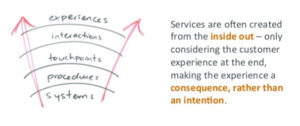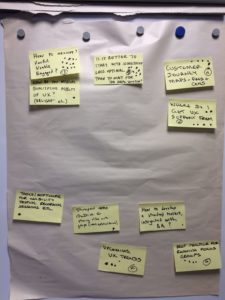Designing intentional user experiences – summary of our December meet up
This week we welcomed Stephen Denning, Director of User Experience (UX) with Edinburgh consultants User Vision as our guest speaker at our lunchtime meet up, before a lively discussion of hot topics the group wanted to explore.
As ever, the session ran over an hour and half lunchtime period, with our speaker and Q&A session taking up the first half, and a group-led agenda (we use the Lean Coffee approach) for the second half discussion.
Stephen’s talk: Designing intentional user experiences
Stephen gave a great talk which really engaged the group and provoked both questions for him at the end, and thoughts feeding into the later discussion session.
He started off by telling a story about Disney’s user experience, what they set about to do around the turn of the century, and how the experience they’ve created sets them apart from competitors in the theme park market.
If you’re interested in this fascinating story, Jared Spool tells a longer version in his talk: “Beyond the UX tipping point”
Watch Jared Spool present “Beyond the UX tipping point” at Webstock 2017 on Vimeo
Stephen talked about a lot of great stuff (slides to come soon, I’ll update this post when I get them) and for me, the most pertinent slides were these:

Services are often created from the inside out: only considering the customer experience at the end, making the experience a consequence, rather than an intention.

We should think about the customer experience and build from that. This makes the customer experience intentional rather than consequential.
I think this is where we are as an institution a lot of the time. Admittedly we’re tied into particular systems and procedure – it would be naive to think that these things can be changed in the short-to-medium term – but we need to spend more time thinking about, communicating and validating the ideal experiences we want for our students, our staff and our collaborators.
If we don’t have an experience vision for key audiences and key scenarios, we’ll never procure the right systems and amend our procedures the right way to ensure we deliver the user experiences that will deliver the greatest business benefits. We’ll keep on procuring and amending according to unvalidated assumptions and exclusively business priorities.
Understanding and working towards the optimal user experiences we want for the University’s business is truly transformational. We shape our offerings around our key customers’ worlds making our digital services more useful, usable, accessible and desirable.
Stephen went on to spend some time talking about definitions of user experience (how it comes down to utility (usefulness), usability (how easy something is to use) and desirability (how our services are perceived, relative to similar experiences our users encounter)) and usability (how efficiency, effectiveness and satisfaction are fundamental to its measurement).
The best way to be as sure (as you can be) of delivering an experience that meets users’ expectations is to establish their needs at the outset (before you’ve decided how or why you’re going to tackle the challenge) and to repeatedly validate these expectations throughout the process of developing or evolving your provision. And beyond the delivery of your service, to continue to make sure that your offering aligns with your users’ needs, attitudes and expectations.
In a nutshell, businesses that deliver great user experiences ruthlessly align their provision to user need, and establish processes and procedures that enable that to happen.
Stephen Denning’s Linkedin profile
Post-talk discussion

The group wrote discussion topics onto post-its, and then everyone assigned 3 dots to the items they most wanted to have discussed.
As we always do at these sessions, the group collaboratively generated and prioritised the discussion agenda.
Here’s what they produced in about 5 minutes, which steered what we talked about for the rest of the session.
The topics we discussed were:
- How to measure useful, usable and engaged? How do you measure qualitative aspects of UX?
- Is it better to start with something less optimal than to wait for the ideal solution?
You can see there are lots of other great topics we didn’t get to in the time remaining. As with last time, hopefully these topics will keep coming up and we can spend some time talking about them in future sessions.
Learn more about the Lean Coffee discussion format
Get involved
I have a great speaker lined up for our next session which is likely to be happening around the end of January. More details in a new blog post very soon.
If you’d like to be notified of this, and other UX-related stuff happening in the University, join our mailing list.
Join the University of Edinburgh UX mailing list (login required)
Did you attend? What did you think?
Your feedback is really important. It helps us improve and helps others decide whether to engage with us.
Leave a comment on this post and share you views.


Sorry I couldn’t be there.
Is it possible to fully ‘establish (user) needs at the outset’? That feels the same to me as asking to ‘predict the course of a relationship’. It’s a living, dynamic interaction and though experience and practiced methodologies help tease out desired end points and predict likely outcomes, evolving and testing interactions in context is the best way to trustable results.
Have we had a session specifically on ‘LX’? Learner experience is the core product interface of a University, and should be a subject of intense interest way beyond UX folks:
http://www.edsurge.com/news/2016-06-20-ux-to-lx-the-rise-of-learner-experience-design
Thanks Brendan. Shame you couldn’t make it as that’s an excellent question that would have been great to discuss in the session. Maybe next time?
I’d say that all you can ever do is get a snapshot of user needs at any point in time. The more frequently you engage with your users and the greater the range of research techniques, the more likely you are to understand their needs. Ongoing validation through the development and life of a service minimises the risk of making a mis-step in delivering an experience.
A future session on learner experiences sounds great. Probably should be a group all of its own! Let’s follow up and get something organised.
Thanks!
This was an excellent session and I felt I really benefited from attending. It gave me lots of ideas and reminders about the importance of UX. The next challenge is/will be building this into new projects I’m involved in. And making sure it’s integrated in all work from the start.